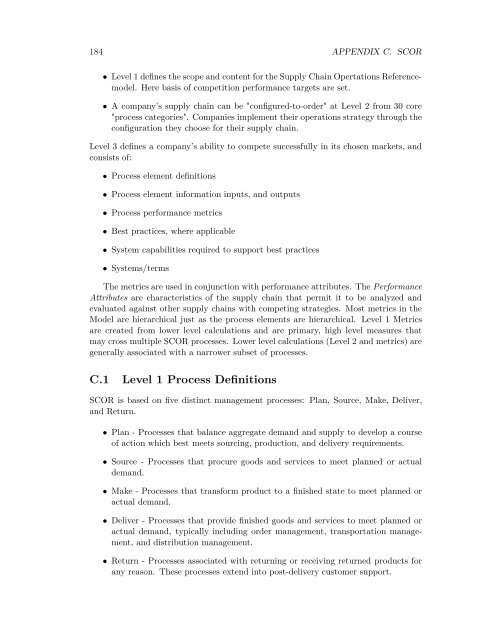Semantic Annotation for Process Models: - Department of Computer ...
Semantic Annotation for Process Models: - Department of Computer ...
Semantic Annotation for Process Models: - Department of Computer ...
Create successful ePaper yourself
Turn your PDF publications into a flip-book with our unique Google optimized e-Paper software.
184 APPENDIX C. SCOR<br />
• Level 1 defines the scope and content <strong>for</strong> the Supply Chain Opertations Referencemodel.<br />
Here basis <strong>of</strong> competition per<strong>for</strong>mance targets are set.<br />
• A company’s supply chain can be "configured-to-order" at Level 2 from 30 core<br />
"process categories". Companies implement their operations strategy through the<br />
configuration they choose <strong>for</strong> their supply chain.<br />
Level 3 defines a company’s ability to compete successfully in its chosen markets, and<br />
consists <strong>of</strong>:<br />
• <strong>Process</strong> element definitions<br />
• <strong>Process</strong> element in<strong>for</strong>mation inputs, and outputs<br />
• <strong>Process</strong> per<strong>for</strong>mance metrics<br />
• Best practices, where applicable<br />
• System capabilities required to support best practices<br />
• Systems/terms<br />
The metrics are used in conjunction with per<strong>for</strong>mance attributes. The Per<strong>for</strong>mance<br />
Attributes are characteristics <strong>of</strong> the supply chain that permit it to be analyzed and<br />
evaluated against other supply chains with competing strategies. Most metrics in the<br />
Model are hierarchical just as the process elements are hierarchical. Level 1 Metrics<br />
are created from lower level calculations and are primary, high level measures that<br />
may cross multiple SCOR processes. Lower level calculations (Level 2 and metrics) are<br />
generally associated with a narrower subset <strong>of</strong> processes.<br />
C.1 Level 1 <strong>Process</strong> Definitions<br />
SCOR is based on five distinct management processes: Plan, Source, Make, Deliver,<br />
and Return.<br />
• Plan - <strong>Process</strong>es that balance aggregate demand and supply to develop a course<br />
<strong>of</strong> action which best meets sourcing, production, and delivery requirements.<br />
• Source - <strong>Process</strong>es that procure goods and services to meet planned or actual<br />
demand.<br />
• Make - <strong>Process</strong>es that trans<strong>for</strong>m product to a finished state to meet planned or<br />
actual demand.<br />
• Deliver - <strong>Process</strong>es that provide finished goods and services to meet planned or<br />
actual demand, typically including order management, transportation management,<br />
and distribution management.<br />
• Return - <strong>Process</strong>es associated with returning or receiving returned products <strong>for</strong><br />
any reason. These processes extend into post-delivery customer support.
















